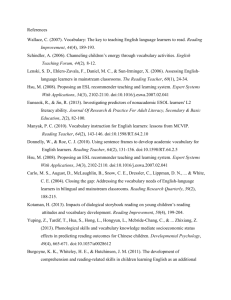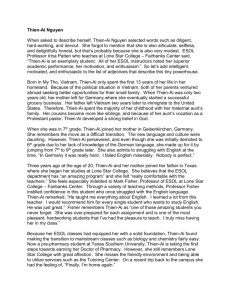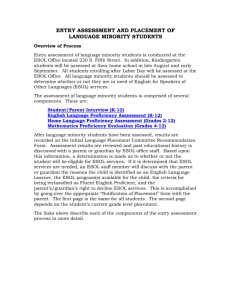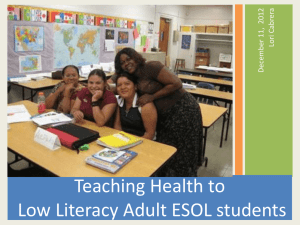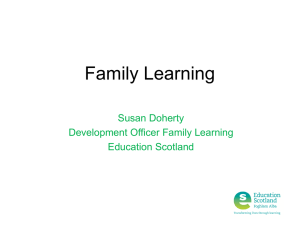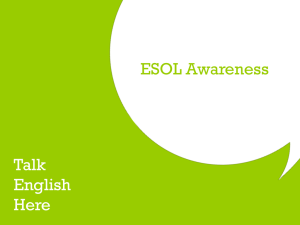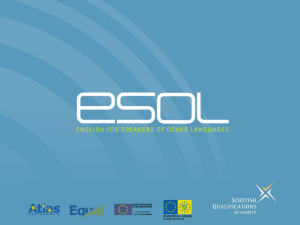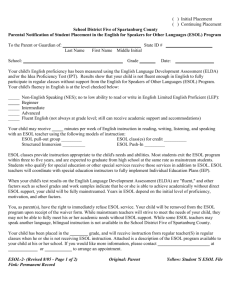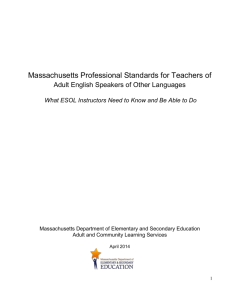References of my project ED 633
advertisement
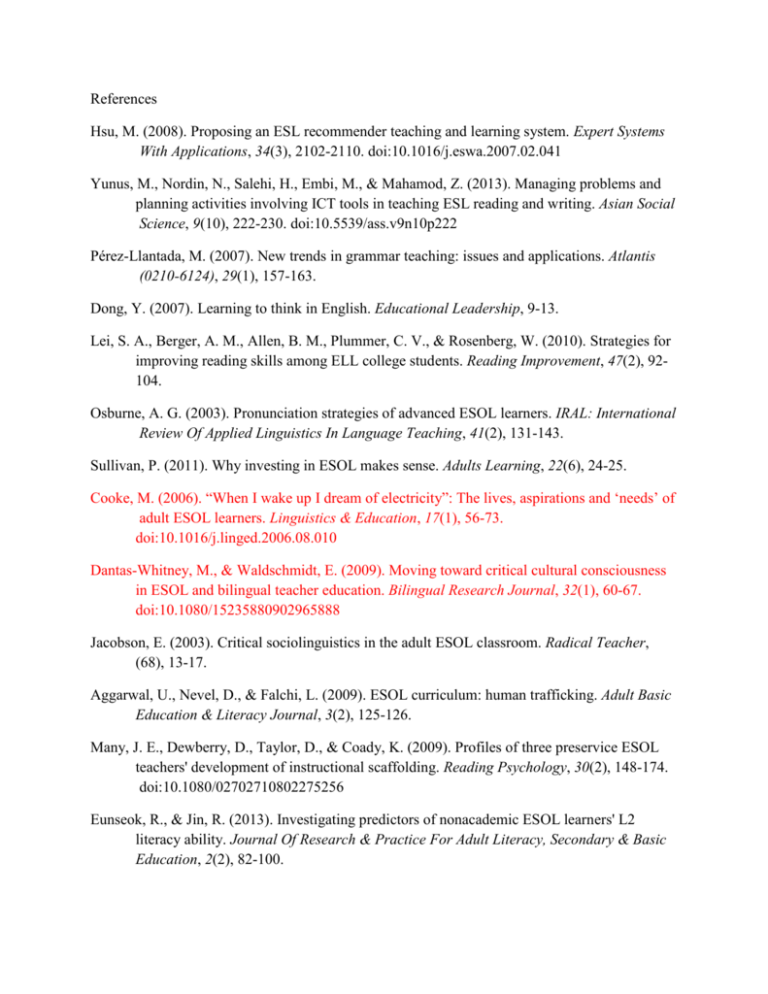
References Hsu, M. (2008). Proposing an ESL recommender teaching and learning system. Expert Systems With Applications, 34(3), 2102-2110. doi:10.1016/j.eswa.2007.02.041 Yunus, M., Nordin, N., Salehi, H., Embi, M., & Mahamod, Z. (2013). Managing problems and planning activities involving ICT tools in teaching ESL reading and writing. Asian Social Science, 9(10), 222-230. doi:10.5539/ass.v9n10p222 Pérez-Llantada, M. (2007). New trends in grammar teaching: issues and applications. Atlantis (0210-6124), 29(1), 157-163. Dong, Y. (2007). Learning to think in English. Educational Leadership, 9-13. Lei, S. A., Berger, A. M., Allen, B. M., Plummer, C. V., & Rosenberg, W. (2010). Strategies for improving reading skills among ELL college students. Reading Improvement, 47(2), 92104. Osburne, A. G. (2003). Pronunciation strategies of advanced ESOL learners. IRAL: International Review Of Applied Linguistics In Language Teaching, 41(2), 131-143. Sullivan, P. (2011). Why investing in ESOL makes sense. Adults Learning, 22(6), 24-25. Cooke, M. (2006). “When I wake up I dream of electricity”: The lives, aspirations and ‘needs’ of adult ESOL learners. Linguistics & Education, 17(1), 56-73. doi:10.1016/j.linged.2006.08.010 Dantas-Whitney, M., & Waldschmidt, E. (2009). Moving toward critical cultural consciousness in ESOL and bilingual teacher education. Bilingual Research Journal, 32(1), 60-67. doi:10.1080/15235880902965888 Jacobson, E. (2003). Critical sociolinguistics in the adult ESOL classroom. Radical Teacher, (68), 13-17. Aggarwal, U., Nevel, D., & Falchi, L. (2009). ESOL curriculum: human trafficking. Adult Basic Education & Literacy Journal, 3(2), 125-126. Many, J. E., Dewberry, D., Taylor, D., & Coady, K. (2009). Profiles of three preservice ESOL teachers' development of instructional scaffolding. Reading Psychology, 30(2), 148-174. doi:10.1080/02702710802275256 Eunseok, R., & Jin, R. (2013). Investigating predictors of nonacademic ESOL learners' L2 literacy ability. Journal Of Research & Practice For Adult Literacy, Secondary & Basic Education, 2(2), 82-100. Huang, J., Dotterweich, E., & Bowers, A. (2012). Intercultural miscommunication: impact on ESOL students and implications for ESOL teachers. Journal Of Instructional Psychology, 39(1), 36-40. Nelson, C. D. (2002). Why queer theory is useful in teaching: a perspective from English as a second language teaching. Journal Of Gay & Lesbian Social Services, 14(2), 43-53. Brown, K. K. (2002). Ideology and context: world Englishes and EFL teacher training. World Englishes, 21(3), 454-457. Matsuda, A. A. (2002). “International understanding” through teaching world Englishes. World Englishes, 21(3), 436-440. Baik, M. J., & Shim, R. J. (2002). Teaching world Englishes via the Internet. World Englishes, 21(3), 437-440. Hsu, M. (2008). Proposing an ESL recommender teaching and learning system. Expert Systems With Applications, 34(3), 2102-2110. doi:10.1016/j.eswa.2007.02.041 Donnelly, W., & Roe, C. J. (2010). Using sentence frames to develop academic vocabulary for English learners. Reading Teacher, 64(2), 131-136. doi:10.1598/RT.64.2.5 Manyak, P. C. (2010). Vocabulary instruction for English learners: lessons from MCVIP. Reading Teacher, 64(2), 143-146. doi:10.1598/RT.64.2.10 Sawin, G. (2000). How to communicate with people who speak English as a second language (ESL). ETC: A Review Of General Semantics, 57(2), 140.

